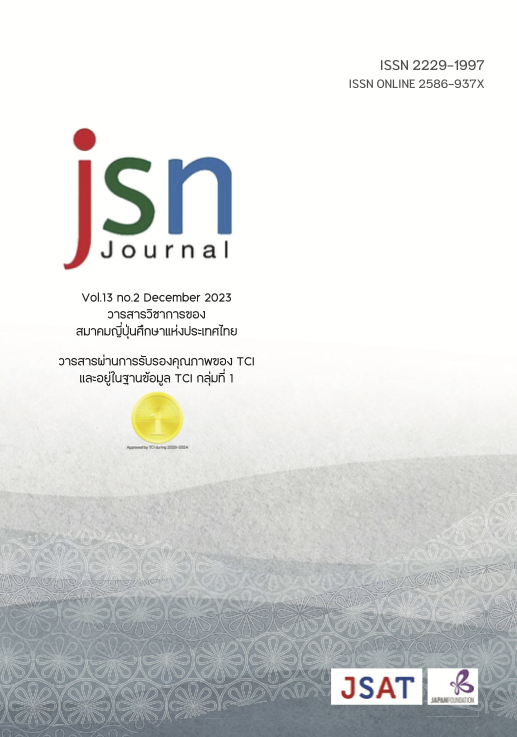Opportunities for Thai People as Specified Skilled Workers in the Food Service Industry in Japan: Challenging Possibilities
Main Article Content
Abstract
This study examines the opportunities and challenges of working in Japan with a Specified Skilled Workers-1 (SSW-1) visa and requirements, including the Japanese language proficiency test (N4/JFT-Basic) and Food Service Industry Skills Proficiency Test. The study found that: 1) There are a lot of opportunities for Thai people to work in the food service industry in Japan under an SSW-1 visa because the current number of SSW-1 workers in this category is only about 10% of the admitted maximum number; 2) Japanese language proficiency plays a critical role in passing the JFT-Basic, the Food Service Industry Skills Proficiency Test, and communicating with Japanese companies; and 3) The lack of communicative competence in the Japanese language can lead to financial challenges in paying recruitment agency to support the application process until starting to work in Japan.
Article Details

This work is licensed under a Creative Commons Attribution-NonCommercial-NoDerivatives 4.0 International License.
ข้อความและข้อคิดเห็นต่างๆ ในบทความเป็นของผู้เขียนบทความนั้นๆ ไม่ใช่ความเห็นของกองบรรณาธิการหรือของวารสาร jsn Journal
References
Cabinet Office. (2018). The concerning the Policies on the Operation of Specified Skilled Worker Visa
Status (in Japanese).
Central Employment Registration and Workers Protection Division. (2023). List of recruitment
agencies for Thai workers to foreign countries. Retrieved from https://www.doe.go.th/prd/assets/upload/files/ipd_th/eef6ece76fad15a78a16a2f2fcfe4e26.pdf
Chonlaworn, Piyada. (2021). Cheap and Dispensable: Foreign Labor in Japan via the Technical Intern
Training Program. JSN Journal, 11 (1), 33-49.
Chonlaworn, Piyada., & Pongsapitaksanti, Piya. (2022). Labor Migration from Thailand to Japan: A Study of
Technical Interns’ Motivation and Satisfaction. Social Sciences Series, 39, 379-397.
Japan Foundation. (2023a). JFT-Basic. Retrieved from https://www.jpf.go.jp/jft-basic/e/about/index.html#se01
Japan Foundation. (2023b). Test implementation report. Retrieved from https://www.jpf.go.jp/jft-basic/e/report/document.html
Ministry of Justice. (2022a). About the Foreign Technical Intern Training Program. Retrieved from https://www.moj.go.jp/isa/content/930005177.pdf
Ministry of Justice. (2022b). The Specified Skilled Worker. Retrieved from https://www.moj.go.jp/isa/content/930004452.pdf
Mizuho Research Institute. (2020). First-year landscape of the new “Specified Skilled Worker” residence status system: Accumulated challenges keep the number of accepted foreign workers much smaller than expected. Retrieved from https://www.mizuhogroup.com/binaries/content/assets/pdf/information-and-research/insights/mhri/mea200608.pdf
Oishi, Nana. (2021). Skilled or unskilled? The recognition of migration policies in Japan. Journal of Ethnic and Migration Studies, 47 (10), 2252-2269.
PRTIMES (2023). 外国人雇用センター. Retrieved from https://prtimes.jp/main/html/rd/p/000000001.000073540.html
Ruth Imam Ochavillo Mary. (2022). Unveiling Japan’s Technical Intern Training and Specified Skilled Workers Programs: Are they substitutes or mutually reinforcing? (Master Thesis). International University of Japan.
外国人食品産業技能評価機構 (2023a). 「外食業国外試験」https://otaff1.jp/gaisyoku/?c=kokugai
外国人食品産業技能評価機構 (2023b). Food Service Industry Skills Proficiency Test (OTAFF) pdf. https://otaff1.jp/img/file/g_sihkenannai_en.pdf
外国人食品産業技能評価機構 (2023c). 「外食業技能測定試験学習用テキスト」http://www.jfnet.or.jp/contents/gaikokujinzai/
外国人食品産業技能評価機構 (2023d). 「特定技能1号外食業技能測定試験学習用テキスト『 接客全般』令和3年4月15日改訂版 」http://www.jfnet.or.jp/contents/_files/gaikokujinzai/jf_customer_service_text_ja_v1.1.pdf
外国人食品産業技能評価機構 (2023e). 「外食業特定技能1号技能測定試験『サンプル問題もんだい』」https://www.maff.go.jp/j/shokusan/gaisyoku/attach/pdf/gaikokujinzai-43.pdf
出入国在留管理庁 (2019).「特定技能在留外国人数」(令和元年12月末現在). https://www.moj.go.jp/isa/content/930004756.pdf
出入国在留管理庁 (2020).「特定技能在留外国人数」(令和2年12月末現在). https://www.moj.go.jp/isa/content/001348999.pdf
出入国在留管理庁 (2021a). Publication of number of resident foreign national specified skilled workers. https://www.isa.go.jp/en/policies/ssw/nyuukokukanri07_00215.html
出入国在留管理庁 (2021b).「特定技能在留外国人数」(令和3年12月末現在). https://www.moj.go.jp/isa/content/001367366.pdf
出入国在留管理庁 (2022). 「特定技能在留外国人数」(令和4年12月末現在). https://www.moj.go.jp/isa/content/001389884.pdf
巣内尚子 (2019).『奴隷労働-ベトナム人技能実習生の実態』東京:花伝社.
宮島喬・鈴木江里子 (2019).『新版外国人労働者受け入れを問う』東京:岩波書店.
村上英吾 (2019).「外国人技能実習制度と貧困」『貧困研究』22,66-74.
湯山英子・設樂澄子(2018).「北海道における在留ベトナム人の現状と課題-技能実習生の実態調査から」『平成 30 年度助成研究論文集』(一財)北海道開発協会開発調査総合研究所,115- 139.

